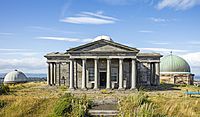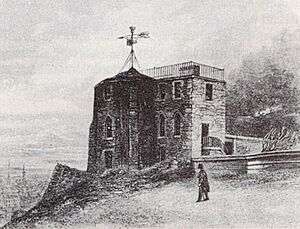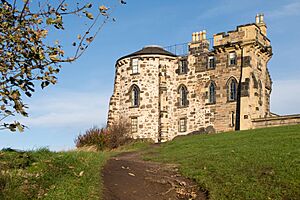City Observatory facts for kids
Quick facts for kids City Observatory, Edinburgh |
|||||||
|---|---|---|---|---|---|---|---|

Front of the Playfair Building
|
|||||||
| Code | 961 | ||||||
| Location | Calton Hill, Edinburgh, Scotland | ||||||
|
Coordinates
|
55°57′17″N 3°11′0″W / 55.95472°N 3.18333°W
|
||||||
| Altitude | 107 m | ||||||
| Established | 1776 | ||||||
| Closed | 2009 | ||||||
|
|||||||

The City Observatory is a famous old building on Calton Hill in Edinburgh, Scotland. It used to be a place where people studied the stars and planets. You might also hear it called the Calton Hill Observatory.
The observatory area is surrounded by a wall. Inside, you'll find a monument to John Playfair, who was important to the Edinburgh Astronomical Institution. The oldest part is the Gothic Tower. It looks like an old castle tower and faces Princes Street and Edinburgh Castle. It's also called Observatory House or James Craig House, named after its designer James Craig.
The main building looks like an ancient Greek temple. It's called the Playfair Building, after its designer William Henry Playfair. This building once held a 15 cm (6-inch) refractor in its dome. It also had a 16 cm (6.4-inch) transit telescope in its eastern wing. The largest dome on the site is the City Dome. In the early 1900s, it held a big 56 cm (22-inch) refractor telescope.
In 2018, the whole site was fixed up and new buildings were added. The City Observatory opened to the public for the first time on November 24, 2018. It is now called Collective, a place for modern art.
Contents
How the Observatory Started
Thomas Short's Observatory
In 1776, a man named Thomas Short came back to Edinburgh. He brought a large 3.7 m (12-foot) reflecting telescope. His brother, James Short, had made it. Thomas wanted to open a public observatory on Calton Hill to make money.
However, in 1736, Colin Maclaurin, a math professor at the University of Edinburgh, had already collected money for a university observatory. Because of some local unrest and a rebellion, the money wasn't used. This money was then given to help build Short's observatory. The City of Edinburgh also gave him land on Calton Hill. The observatory was meant to be open to university students.
James Craig designed the observatory. He wanted it to look like a strong fort with Gothic towers. The city managed the building project. But they ran out of money after only one tower was built. Short moved into this tower and ran the observatory until he died in 1788. A smaller observatory was also built where the Playfair Building is now. After Short died, his family kept the observatory going for a while. Then it was rented out and finally closed around 1807. The land went back to the city.
Thomas Short's daughter, Maria Theresa Short, returned to Edinburgh in 1827. She opened another observatory on Calton Hill. This one was for the public and for fun, not just for science. In 1850, it moved to Castle Hill. Today, her business is the Camera Obscura on the Royal Mile.
The Royal Observatory
In 1812, the observatory was given to the Edinburgh Astronomical Institution. They opened their public observatory in the Gothic Tower. In 1818, work began on the Playfair Building. William Henry Playfair designed it to be the main scientific observatory for the Institution. After a visit from King George IV in 1822, it became the Royal Observatory.
Again, there wasn't enough money. So, buying instruments and hiring an observer depended on government funding. After many delays, the instruments were ready in 1831. This included the transit telescope. Fraunhofer made the lens. After he died, Repsold and then his son finished and installed the telescope.
In 1834, Thomas Henderson became the observer. This job was also called the Astronomer Royal for Scotland. He was also a professor at the University of Edinburgh. He worked on Calton Hill until he died in 1844. In 1839, he shared his findings about the distance to a star called alpha Centauri. He had made these observations in 1832 and 1833 at the Royal Observatory, Cape of Good Hope.
In 1846, Charles Piazzi Smyth became the second Astronomer Royal for Scotland. He worked on organizing and publishing Henderson's old observations. By 1847, the Astronomical Institution had run out of money. They gave the Royal Observatory over to the Government.
The main job of the observatory was to provide a time service. They watched how stars moved across the sky. This helped them keep the observatory clock very accurate. Accurate time was important for navigation (finding your way). Sailors would bring their ship's clocks from the port of Leith up to Calton Hill to be set correctly.
In 1854, a time ball was put on Nelson's Monument, right next to the observatory. Sailors could see it from the port. This ball dropped at a certain time each day. It was controlled by electrical signals from the observatory clock. A few years later, the One O'Clock Gun on Edinburgh Castle was added. This cannon also fired at 1 PM. It was controlled by an electrical wire that stretched across the city from Calton Hill to the Castle. Today, the time ball and One O' Clock Gun are popular tourist sights. They are no longer controlled by the observatory.
By 1888, when Smyth left, the observatory's equipment was old and outdated. Also, the observatory was too close to the city. City lights made it hard to see the stars clearly. In 1896, the Royal Observatory moved to a new place on Blackford Hill. The Calton Hill Observatory once again went back to the City of Edinburgh.
The City Observatory
After the Royal Observatory moved, a new City Observatory was created on Calton Hill around the late 1800s. A 15 cm (6-inch) telescope was given by William McEwan. It was put in the dome on the Playfair Building. Other domes were built for different telescopes. The City Dome was built for a large 56 cm (22-inch) telescope. This telescope didn't work very well and was taken apart in 1926. The dome stayed and was used as a lecture hall.
The observatory opened in 1898 with William Peck as the City Astronomer. After Peck died in 1925, his assistant, John McDougal Field, continued to run the City Observatory.
In 1924, the Astronomical Society of Edinburgh was formed. Field was its first president. In 1938, the observatory was leased to the Society. They ran the City Observatory until 2009. At that time, damage and theft made the site unusable.
Collective Art Centre
In 2009, the Astronomical Society of Edinburgh moved out of the City Observatory. The buildings went back to the City of Edinburgh Council. The Council began to fix up the buildings in 2012. They worked with a visual arts group called Collective.
After a big project that cost £4.5 million, Collective reopened the City Observatory site in 2018. It is now a modern art center and restaurant. A new exhibition space, called the Hillside, shows art by Scottish artists. The restored City Dome shows works by international artists. William Playfair's Observatory has been restored to how it looked originally. The old Transit instrument is now on display for everyone to see. Observatory House was also renovated in 2021 and is now available for short-term stays.
Images for kids













